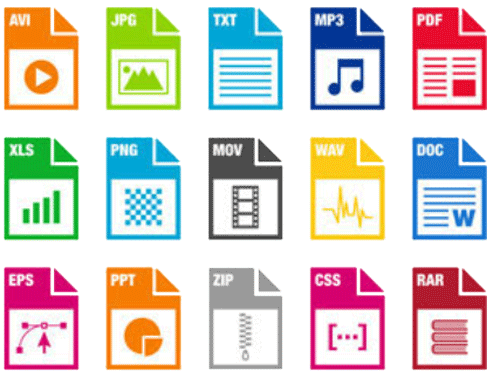What is File? Types of File Extension
What is File?
A file a container in a computer system that stores data, information, settings, or commands, which are used with a computer program. In graphical user interface (GUI), such as Microsoft operating systems, represent the files as icons, which associate to the program that opens the file. For instance, the picture is shown as an icon; it is related to Microsoft Word. If your computer contains this file and you double-click on the icon, it will open in Microsoft Word installed on the computer.

There are several types of files available such as directory files, data files, text files, binary and graphic files, and these several kinds of files contain different types of information. In the computer system, files are stored on hard drives, optical drives, discs, or other storage devices.
In most of the operating systems, a file must be saved with a unique name within a given file directory. However, certain characters cannot be used during creating a file as they are considered illegal. A filename is consisted of with a file extension that is also called a suffix. The file extension contains two to four characters that follow the complete filename, and it helps to recognize the file format, type of file, and the attributes related to the file.
Most modern computer systems have the ability to protect files from file corruption or damage. The file can be contained the data from system-generated information to user-specified information. File management is done manually at times with the help of the user or done with the help of third-party tools and operating systems
.The basic operations that can be performed on a file are given below:
- Closing or terminating a file operation
- Creation of programs
- Reading of data from the file
- Creation of a new file
- Opening the file in order to make the contents available to other
- Modification of data or file attributes
- Writing data to the file
File Format
The file format is the structure of a file that arranges the data logically within a file. It allows a program to represent the information correctly, retrieve data, and continue with processing. For instance, a Microsoft Word document will be saved with .doc file format; it will be best viewed in Microsoft Word software. Although another software can open this file, it may not have all features to display the document properly, like Microsoft Word. The programs may be able to give an overview of a file if they are compatible with the file format. But they may be unable to display all the files features.
Additionally, some of the programs that are not supported with a file format maybe give you garbage with opening a file. For example, if you will open a.XLS file in another program like notepad, it will not display the document properly and give you garbage. A file format minimizes the required storage space as it contains the data encoding process. For instance, video and picture are encoded by embedded processes like compression; in this process, a picture is divided into pixels.
Furthermore, it also includes presentation information. For example, a Microsoft .xls file includes both the document's text and its final form, as well as table, color, calculations, font size, charts, and other information that must be organized in a standard form inside the file.

Common file formats
Below is a table that contains common file formats you are most likely to see while working on a computer.
File type File extension Image .bmp .eps .gif .jpg .pict .png .psd .tif Text .asc .doc .docx .rtf .msg .txt .wpd .wps Video .avi .mp4 .mpg .mov .wmv Compressed .arc .arj .gz .hqx .rar .sit .tar .z .zip Program .bat .com .exe Sound aac .au .mid .mp3 .ra .snd .wma .wav File Extension
A file extension is an identifier that helps identify the type of file in operating systems, such as Microsoft Windows. It can be classified as a type of metadata, and it helps the operating systems to understand the intended use of a file and the characteristics. The filename extension may be contained one to four characters and used as a suffix to the file name. For example, in Microsoft Windows, the file extension is often followed by three characters.

A dot (.) symbol is used to separate the file extension from the filename. The filename is considered incomplete without file extension; therefore, to complete a filename, it must be included in the file extension. Generally, file extensions are hidden from the users in Windows operating systems. Although file extensions can be renamed, it is not necessarily by renaming a file extension will convert one file format to another. File extensions are helpful for both users and the file system in two ways:
- It helps in identifying the type of data that a file hold.
- It allows the operating system to select the proper program or application with which to open a file.
- Windows XP: It contains a limit of 255 characters.
- Windows 7: It includes a limit of 260 characters.
- Windows 2000: Its limit is 254 characters.
- Windows Vista: Its limit is 260 characters.
- Windows 8: It includes a limit of 260 characters.
- Windows 10: It contains a limit of 260 characters.
What makes a valid file name extension?
A filename extension is always at the end of the file name, which starts with a period (After dot symbol). Although it is often between one and three characters, some of the programs also support more than three characters. For instance, in the latest versions of Microsoft Word file will be saved with .docx extension and some web pages with .html file extension.
Can be a file extension more than three or four characters?
Yes, a file extension can be more than three or four characters. It depends on the program of how it was designed. Some of the programs are designed to identify and open a program with a longer (more than three or four characters) file extension. However, most programs do not exceed four characters to keep the overall file name short.
Limit of a file extension
Until the file name, path, and extension are not combined, the limit of file extension does not exceed the limit of the maximum file name character. There is given a list below, which contains Microsoft operating systems (Windows) versions and their filename character limit.
Different types of file extension
There are various types of file extensions that can be connected with one or more applications. Below is given a list that contains some of the more common file extensions and their related programs.
Music and sound files.wav
.mp3
Picture files
.bmp
.jpg
.gif
Text and word processing documents
.doc
.rtf
.docx
.txtOperating system files
.dll
.exe
Web Page files
.htm
.html
Spreadsheet files
.xls
.xlr
.xlsx
.csv


Comments
Post a Comment